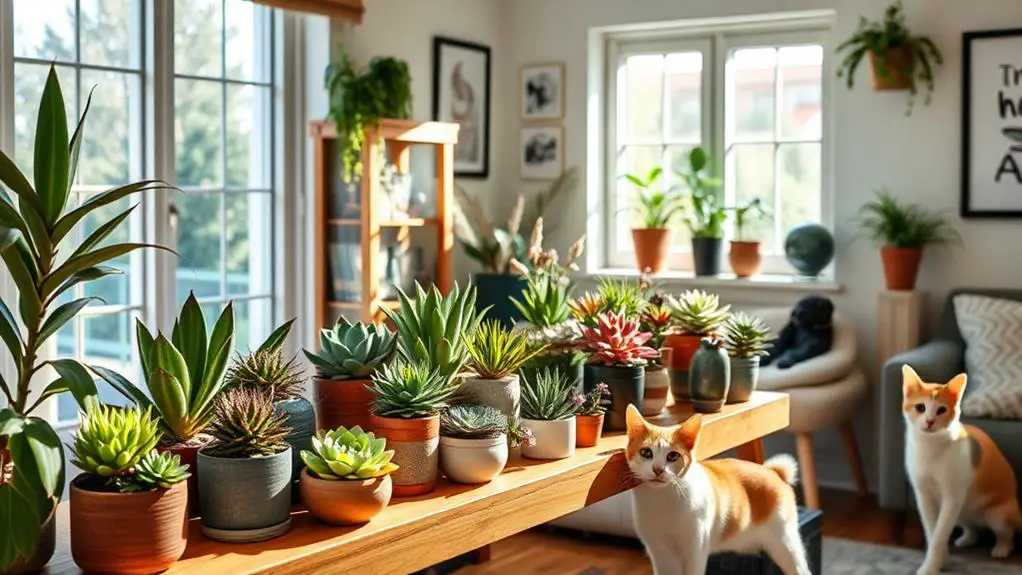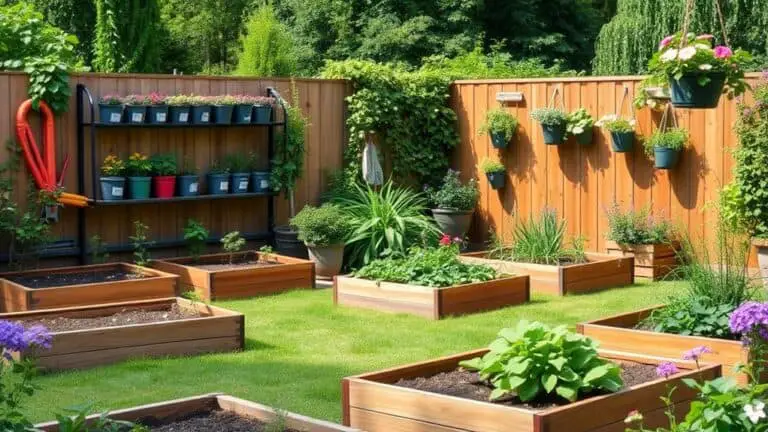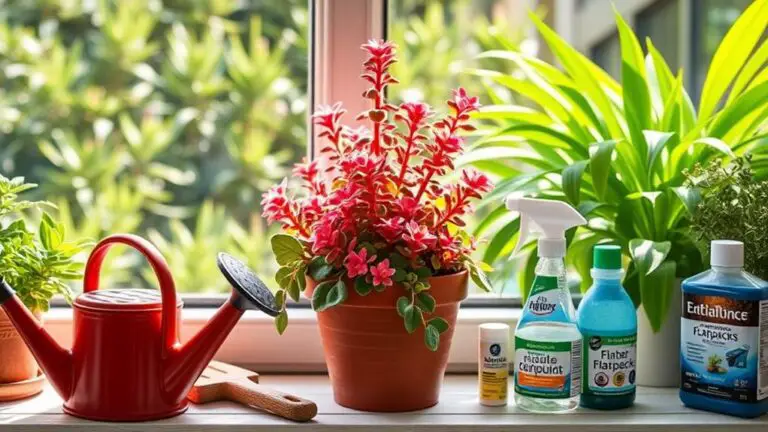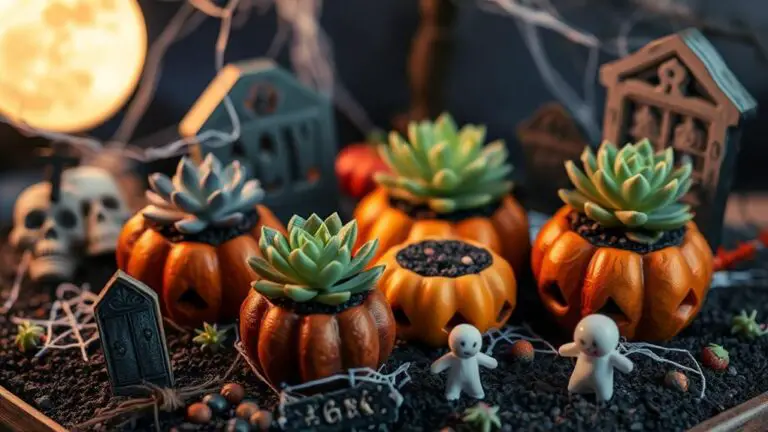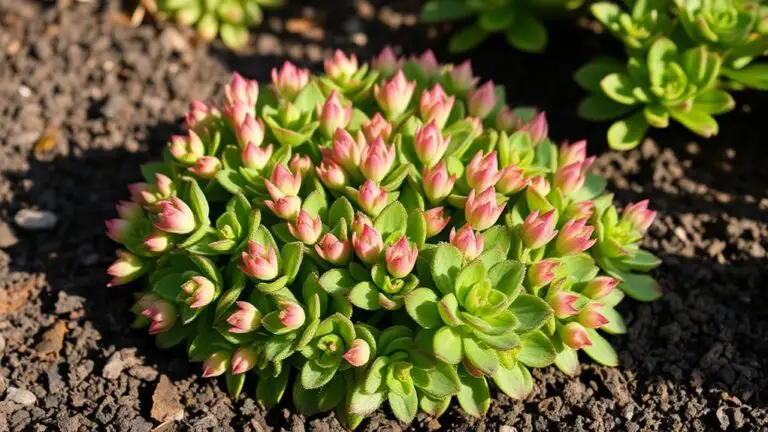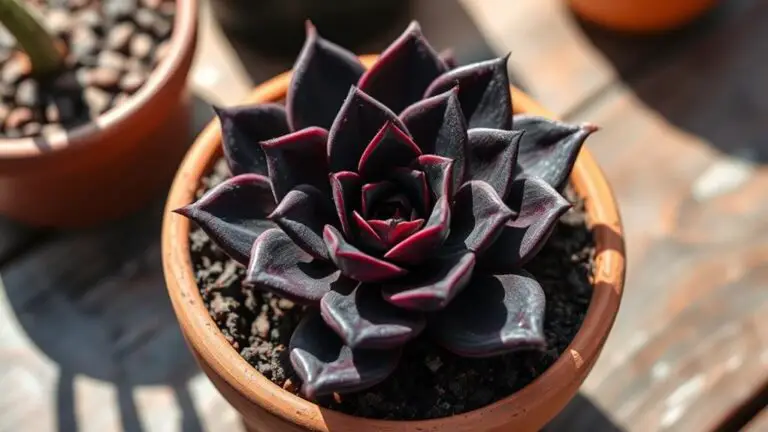10 Non-Toxic Pet-Friendly Succulents for Your Home
When you're looking to spruce up your home with plants, it's essential to take into account the safety of your pets. Fortunately, there are some beautiful, non-toxic succulents that can add charm to your space without posing a risk to your furry friends. From the resilient Sempervivum, commonly known as Hens and Chicks, to the striking Zebra Haworthia, these plants are perfect for pet owners. Not only do they require minimal upkeep, but they also thrive in various lighting conditions. Curious to discover which other succulents make the list and how they can fit into your home décor?
Sempervivum (Hens and Chicks)
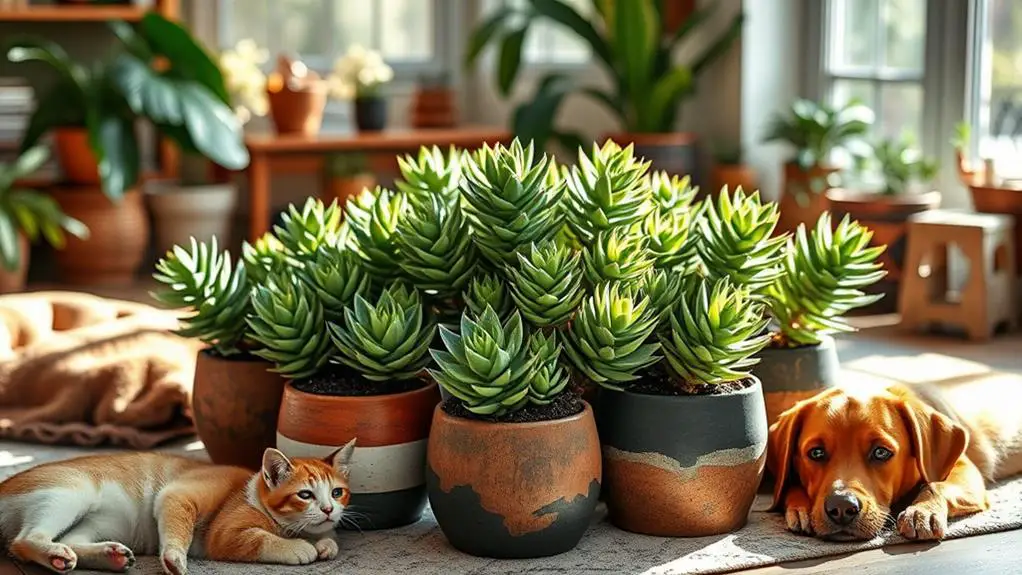
If you're looking for a hardy, pet-friendly succulent, Sempervivum, commonly known as Hens and Chicks, is an excellent choice. This plant can withstand temperatures as low as -20°F, making it suitable for various climates.
Sempervivum forms dense mats of compact rosettes, which produce offsets or "chicks" after flowering. This feature makes it easy to propagate and expand your garden.
One of the best aspects of Sempervivum is that it's non-toxic to pets. You won't have to worry about your cats or dogs getting sick if they decide to explore or nibble on these plants. This peace of mind is priceless for pet owners who want to enjoy beautiful greenery without any risks.
Sempervivum is also low-maintenance, which is perfect if you're busy or new to gardening. It thrives in well-draining soil and prefers full sun to partial shade.
You won't need to water it often, as these succulents are drought-tolerant. Just make sure the soil dries out between waterings.
Sedum Donkey Tail
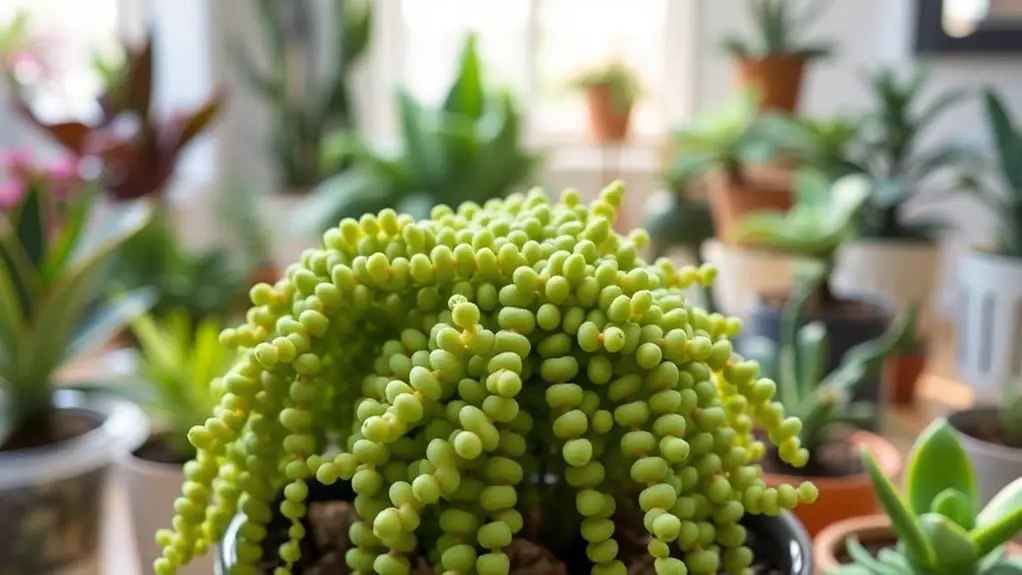
Sedum Donkey Tail is a fantastic succulent to add to your collection, especially if you have pets.
It thrives in well-draining soil with bright, indirect sunlight and only needs watering every two to three weeks, making it super low-maintenance.
Plus, it's non-toxic, so you can rest easy knowing that your cats and dogs are safe around it.
Care and Maintenance
When tending to your Sedum Donkey Tail, understanding its specific care requirements guarantees it thrives in your home. This succulent is an ideal choice for hanging planters, with its cascading stems and plump, rounded leaves.
To provide the best care, place your Sedum Donkey Tail in bright, indirect light. It can handle some direct sun, but too much can scorch its leaves.
For maintenance, start with the right soil. Use a well-draining cactus or succulent mix to prevent root rot. Avoid heavy potting soils.
When it comes to water, less is more. Allow the soil to dry out completely between waterings. Typically, watering every two to three weeks is sufficient. Overwatering can harm your plant, so it's better to err on the side of caution.
Regular pruning helps maintain a bushy appearance. Cut back leggy stems and remove any damaged or dried leaves. This encourages new growth and keeps your plant healthy.
Benefits for Pets
While ensuring your Sedum Donkey Tail thrives with proper care, it's equally important to contemplate its benefits for pets. This plant is completely non-toxic to pets, making it a safe addition to any home with animals. You won't have to worry about your furry friends nibbling on the leaves since it's pet-friendly.
Sedum Donkey Tail's beauty without risk is a significant advantage. Its trailing stems can grow up to two feet long, giving your home an attractive, cascading look. This aesthetic appeal enhances your décor without posing any danger to curious pets.
Plus, the succulent's resilience to drought means you don't have to water it often. This reduces the chance of water-related issues like spills or overwatering, which can affect both the plant and your pets.
Another benefit is that Sedum Donkey Tail prefers bright, indirect light and can tolerate different soil types. This makes it easy to care for in a pet-friendly environment.
You'll find that maintaining a beautiful, safe home for your pets and plants is both simple and rewarding. Embrace the joy of a pet-safe, green space without any hassle!
Christmas Cactus
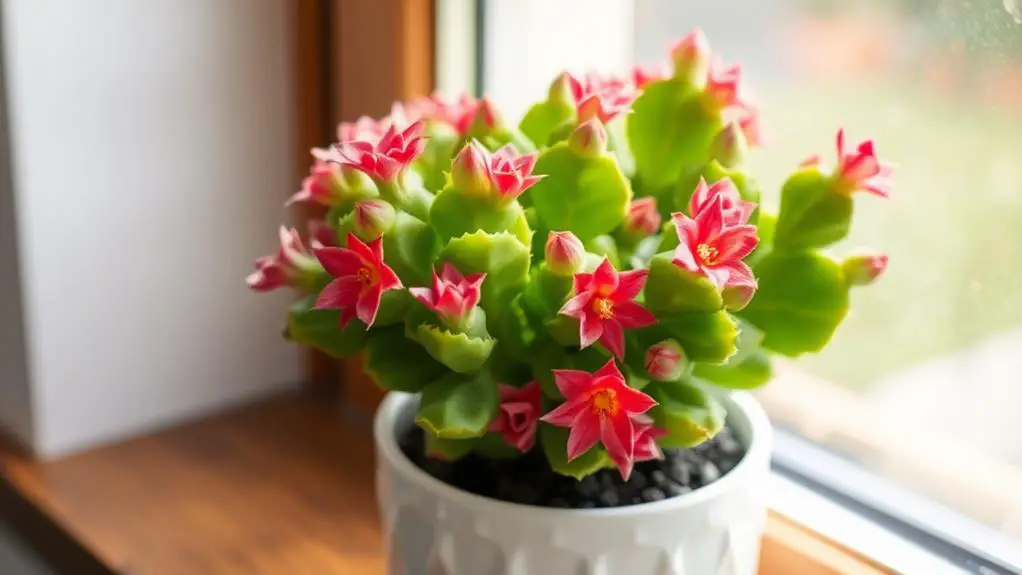
Known for its vibrant red-pink blooms that grace homes around Christmas and Thanksgiving, the Christmas Cactus, or Schlumbergera, is a cherished holiday plant. This stunning succulent isn't only beautiful but also non-toxic, making it safe for your pets. You can place it in your indoor spaces without worrying about your furry friends getting sick.
Unlike many other succulents, the Christmas Cactus prefers moderate to low light conditions, thriving in indirect sunlight. This makes it perfect for brightening up those shadowy corners of your home.
To keep it healthy, verify it's planted in well-draining soil and water it when the top inch of soil feels dry. Be careful not to overwater, as this can lead to root rot.
If you love sharing plants with friends and family, you'll be happy to know that the Christmas Cactus is easy to propagate. Just take a stem cutting, let it dry for a day, and then plant it in fresh soil.
With a little care, you'll have new plants in no time.
Zebra Haworthia
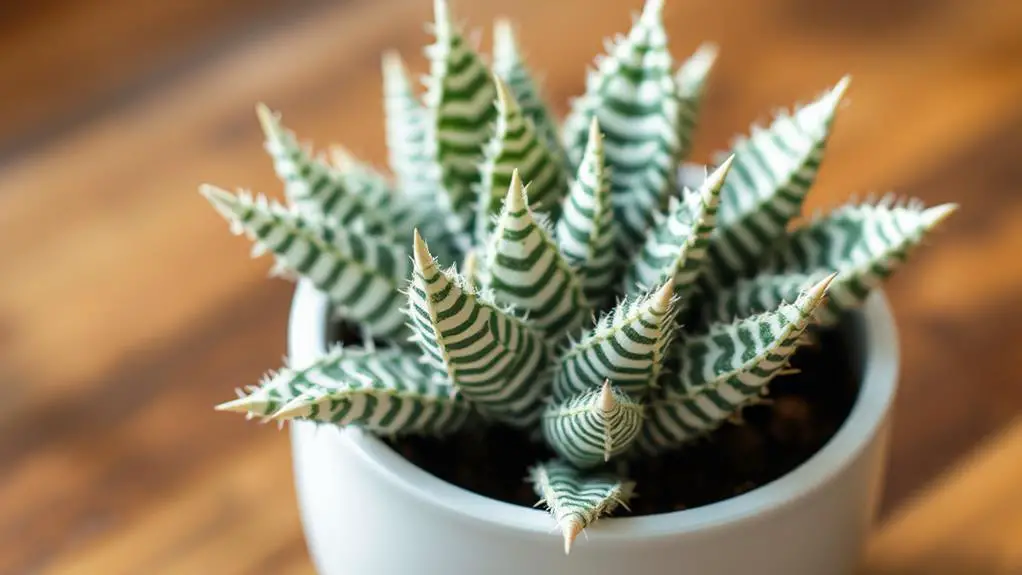
Zebra Haworthia, scientifically known as Haworthia fasciata, stands out with its striking green leaves adorned with white horizontal stripes, resembling a zebra's pattern.
It's a perfect choice if you're looking for a unique, non-toxic plant that's safe for your pets. Plus, it's incredibly low-maintenance, making it ideal for busy households or those new to plant care.
This succulent thrives in bright, indirect sunlight and prefers well-draining soil, so it's well-suited to indoor environments. You won't need to fuss much over it; just water every two to three weeks, depending on your home's humidity and temperature.
Zebra Haworthia is also known for producing offsets, which means you can easily propagate and expand your collection.
Here's why you'll love having Zebra Haworthia in your home:
- Non-toxic to pets, ensuring your furry friends stay safe.
- Low-maintenance, requiring minimal watering and care.
- Thrives indoors, perfect for bright, indirect light spots.
- Striking appearance, with its unique zebra-striped leaves.
- Easy propagation, allowing you to grow more plants effortlessly.
Echeveria
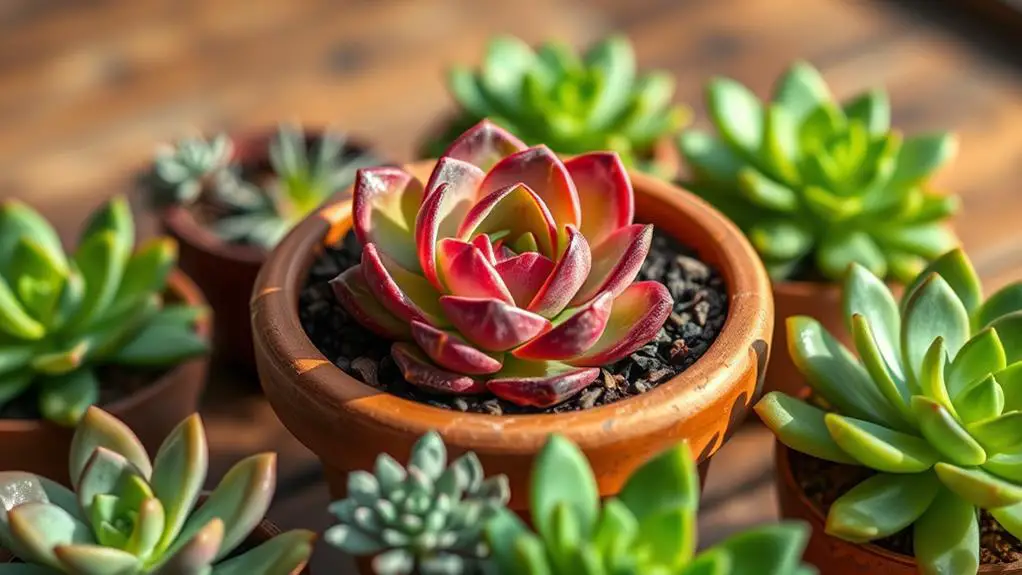
Echeveria succulents captivate with their stunning rosette shapes and a dazzling array of colors, making them a favorite for both indoor and outdoor gardening.
These succulents aren't only beautiful but also easy to care for, making them perfect for beginners and seasoned plant lovers alike.
One of the best things about Echeveria is that they're non-toxic and pet-friendly. You don't have to worry if your curious pets decide to take a nibble.
Echeveria plants thrive in bright, indirect sunlight, so place them near a window where they can soak up plenty of light. These hardy succulents are highly drought-tolerant, so you only need to water them when the soil is completely dry. Overwatering can harm them, so it's better to err on the side of less water.
Echeveria can grow up to 12 inches tall and often produce vibrant flowers on tall stems, adding a pop of color to your space.
They're also easy to propagate. Simply take leaf cuttings or offsets, and you'll have new plants growing in no time. This makes it easy to expand your collection or share plants with friends.
Portulacaria Afra
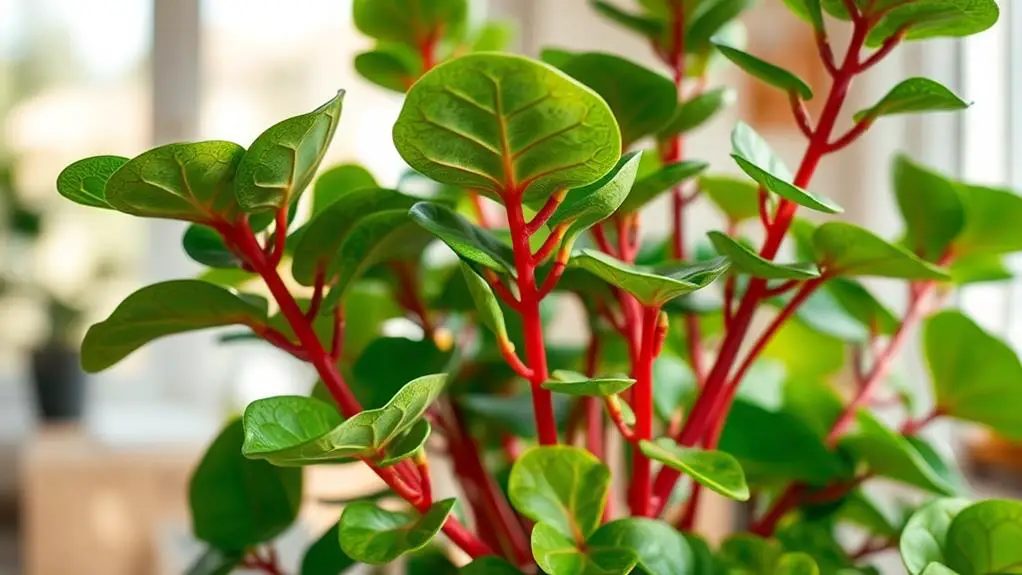
Portulacaria afra, often called the Elephant Bush, is a versatile and resilient succulent you'll love having in your collection. This plant, native to South Africa, is known for its small, round, green leaves and bushy growth habit. It's not only beautiful but also incredibly practical for both novice and experienced gardeners.
One of the best things about Portulacaria afra is that it's pet friendly. You won't have to worry about your furry friends nibbling on its leaves because it's non-toxic. This makes it an excellent choice for households with pets.
Here are some reasons why you'll love Portulacaria afra:
- Drought-resistant: This succulent can store water in its leaves, making it low-maintenance.
- Thrives in bright light: Perfect for sunny spots indoors or outdoors.
- Easy to propagate: You can grow new plants from cuttings.
- Ideal height: It can grow up to 3-4 feet tall, adding a lovely vertical element to your space.
- Well-draining soil: It prefers well-draining soil, which helps prevent root rot.
This succulent isn't only easy to care for but also a beautiful addition to your home. By choosing Portulacaria afra, you're opting for a pet-friendly, non-toxic, and stunning plant that will thrive with minimal effort.
Graptopetalum

Graptopetalum succulents are a fantastic choice if you want colorful, pet-safe plants with unique leaf shapes in shades of pink, purple, and green.
They thrive in bright, indirect sunlight and don't need frequent watering, making them low-maintenance.
Plus, they're easy to propagate from leaf cuttings, so you can grow your collection with little effort.
Unique Leaf Shapes
Amid the diverse world of succulents, species within the Graptopetalum genus stand out due to their unique leaf shapes and vibrant rosette formations.
These succulents boast fleshy leaves that often come in stunning shades of pink, grey, and green. Their distinct leaf structures make them an enchanting addition to any indoor garden.
One of the best things about Graptopetalum succulents is that they're safe to keep around pets. They're non-toxic, so you don't have to worry if your furry friends decide to investigate your new green companions.
Plus, their adaptability to bright light means they can thrive indoors, adding a touch of nature to your living space.
Here are some highlights of the Graptopetalum's unique leaf shapes:
- Color Variety: Leaves can range from pink to grey to green.
- Rosette Formations: These create visually stunning arrangements.
- Farina Coating: A powdery layer that protects against sun and water loss.
- Pet-Friendly: Safe and non-toxic for homes with pets.
- Adaptability: Thrives well in bright indoor light.
With their striking appearance and easy care, Graptopetalum succulents are a delightful and safe addition to any home.
Propagation Made Easy
While the unique leaf shapes of these succulents add a visual charm to your indoor garden, it's equally rewarding to know how easy it is to propagate them. Graptopetalum succulents are incredibly beginner-friendly, making propagation a breeze. To get started, select healthy leaves from the parent plant. Gently twist off the leaves, ensuring they come off cleanly without tearing.
Next, let the cut ends callous over for a day. This step is essential for preventing rot when you plant them. Once calloused, place the leaves on well-draining soil. Lightly mist the leaves to keep the humidity up, but avoid overwatering. In a few weeks, you'll see new roots and tiny plantlets forming at the base of the leaves, signaling successful propagation!
Here's an easy guide:
| Step | Action | Tips |
|---|---|---|
| 1. Select Leaves | Choose healthy leaves | Avoid damaged leaves |
| 2. Callous Ends | Let cut ends dry for a day | Prevents rotting |
| 3. Planting | Place on well-draining soil | Use cactus or succulent mix |
| 4. Mist & Wait | Mist lightly, maintain humidity | Roots form in a few weeks |
Propagation works year-round, but spring and summer yield the best results. Graptopetalum's resilience means you'll likely succeed even if conditions aren't perfect. Happy gardening!
Bright Light Preferences**
Guaranteeing your Graptopetalum receives adequate light is essential for its health and vibrant appearance. These succulents thrive in bright, indirect sunlight, making them perfect for sunny windowsills and well-lit indoor spaces.
You'll want to provide at least 4-6 hours of bright light daily to help maintain their vibrant colors and compact growth. Insufficient light can cause elongated stems and pale leaves, a clear sign that your plant is stretching towards the light source.
To get the best light for your Graptopetalum, consider the following tips:
- Place your succulent near a window that gets plenty of indirect sunlight.
- If you notice your plant leaning, rotate it regularly to guarantee even light exposure.
- While they can handle direct sunlight, offer some shade during the hottest part of the day to avoid leaf scorch.
- Use a sheer curtain to filter intense sunlight if your window is too bright.
- Monitor your plant's health and adjust its position if you see signs of light stress.
Aeonium
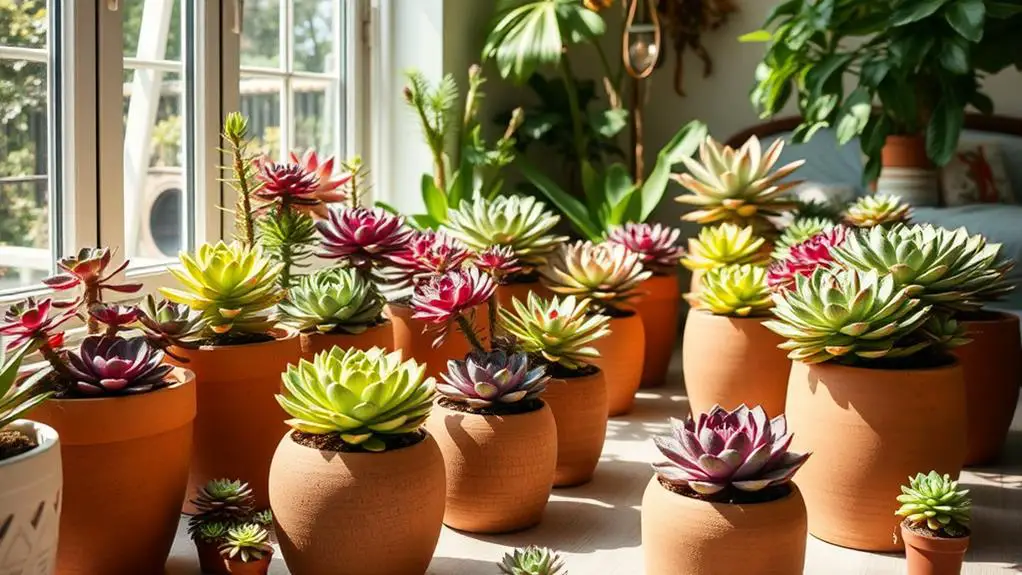
Aeonium, an enchanting genus of succulent plants, boasts rosette-shaped leaves and vibrant colors that make them a favorite for both indoor and outdoor gardening enthusiasts.
These succulents are versatile and can thrive in various light conditions. They prefer bright, indirect sunlight but can tolerate some shade, making them adaptable to different spots in your home.
One of the best things about aeoniums is that they're non-toxic to pets. If you have curious cats or dogs that like to nibble on plants, you won't have to worry about them getting sick from these succulents. This makes aeoniums a safe and beautiful addition to any pet-friendly home.
Aeoniums have a unique growth pattern. Their rosettes can sprout long stems, especially in the spring, creating an eye-catching display. They bloom with yellow or white flowers, adding even more charm.
During the growing season, which is spring and summer, regular watering is essential. However, make sure to let the soil dry out completely between waterings to prevent root rot.
Lithops
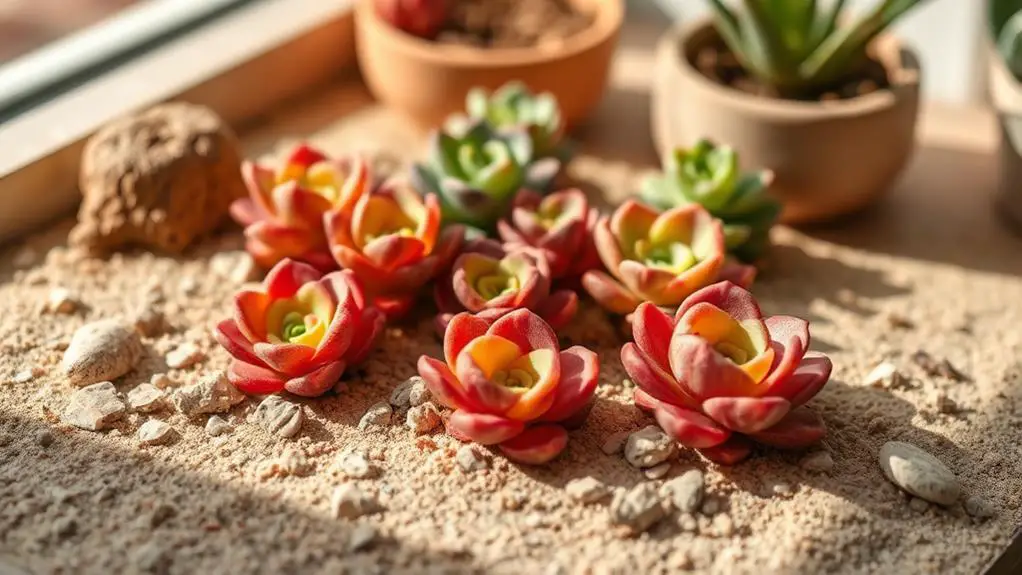
Lithops, often called Living Stones, are fascinating succulents that resemble small stones or pebbles, offering a unique and intriguing look for any indoor garden.
These slow-growing succulents thrive in bright light and need minimal watering, making them perfect for low-maintenance gardening. Plus, Lithops are pet-safe, so you don't need to worry about your cats or dogs nibbling on them.
What makes Lithops even more appealing is their ability to blend into their surroundings, which can deter curious pets.
To keep your Lithops healthy, plant them in well-draining soil and use pots with drainage holes to prevent root rot. This guarantees they live long and happy lives in your home.
Here's why Lithops are a great choice for pet owners:
- Pet-safe: Non-toxic to cats and dogs.
- Low maintenance: Requires minimal watering.
- Bright light: Thrives in well-lit areas.
- Camouflage: Blends in, deterring pets from eating them.
- Healthy growth: Needs well-draining soil and drainage holes.
If you're looking for a unique, non-toxic succulent that's easy to care for, Lithops are an excellent choice. They'll add a touch of nature to your home without compromising your pets' safety.
Gasteria
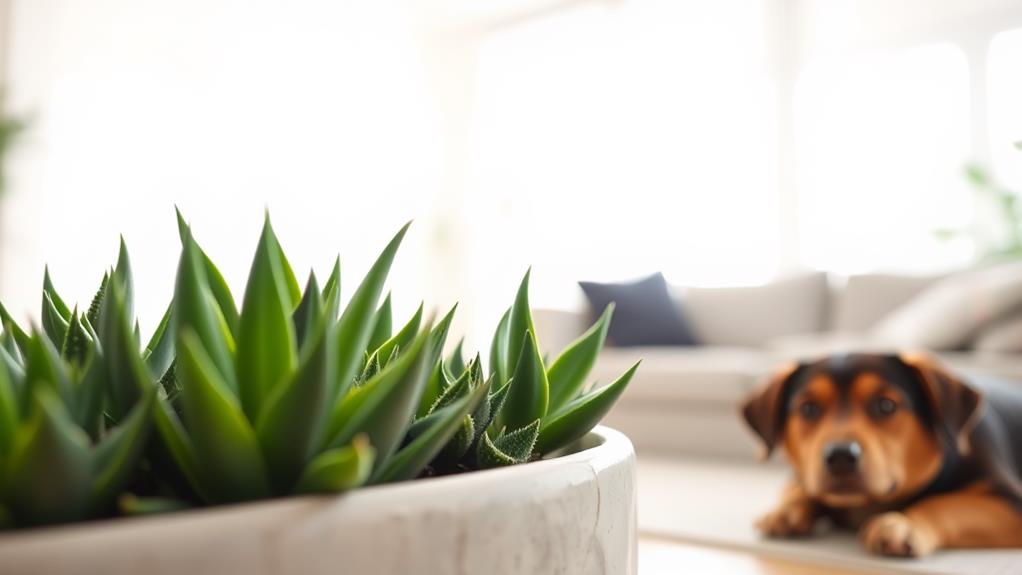
Gasteria brings a sense of tranquility to any home with its thick, fleshy leaves adorned with unique patterns and textures. If you're looking for a succulent that's both beautiful and safe for your pets, Gasteria is a great choice. These plants are non-toxic to pets, so you won't have to worry if your curious cat or dog decides to take a nibble.
Gasteria thrives in bright, indirect light, making it perfect for rooms with filtered sunlight. It prefers well-draining soil to prevent root rot, so choose a cactus or succulent mix for best results.
One of the best things about Gasteria is its drought-tolerant nature, meaning it doesn't need frequent watering. Typically, you'll only need to water it every few weeks, depending on the environment.
In addition to its striking leaves, Gasteria can produce beautiful tubular flowers that bloom on long stalks. These flowers add an extra touch of visual appeal to your indoor space.
Frequently Asked Questions
What Succulents Are Not Poisonous to Dogs?
You can safely choose Echeveria, Sempervivum, Haworthia, Sedum Donkey Tail, and Christmas Cactus for your home. These succulents are non-toxic to dogs, ensuring a beautiful and pet-friendly environment. Enjoy your worry-free greenery!
Are There Any Succulents That Are Safe for Cats?
Yes, there are succulents safe for cats. Consider Haworthia, Echeveria, and Sempervivum, which are non-toxic. Sedum species and Christmas Cactus are also cat-friendly. Graptosedum varieties and elevated String of Turtles are great options too.
What Succulents Purify the Air?
You can choose Aloe Vera, Echeveria, Haworthia, Sempervivum, or Christmas Cactus to purify the air in your home. These succulents absorb toxins and release oxygen, making your indoor environment healthier and more pleasant.
Is It Bad to Have Succulents in Your Room?
It's not bad at all to have succulents in your room. They improve air quality, require minimal maintenance, and can thrive in various light conditions. Plus, they enhance your mood and create a calming atmosphere.
Conclusion
You've got everything you need to create a beautiful, pet-safe garden with these non-toxic succulents. Don't worry about your furry friends; these plants are totally safe. Just remember to place them in bright, indirect sunlight and water them sparingly. With a little care, your home will be greener and your pets will be happy. You can do this! Enjoy your new, vibrant space filled with these lovely, easy-to-maintain succulents. Happy gardening!

